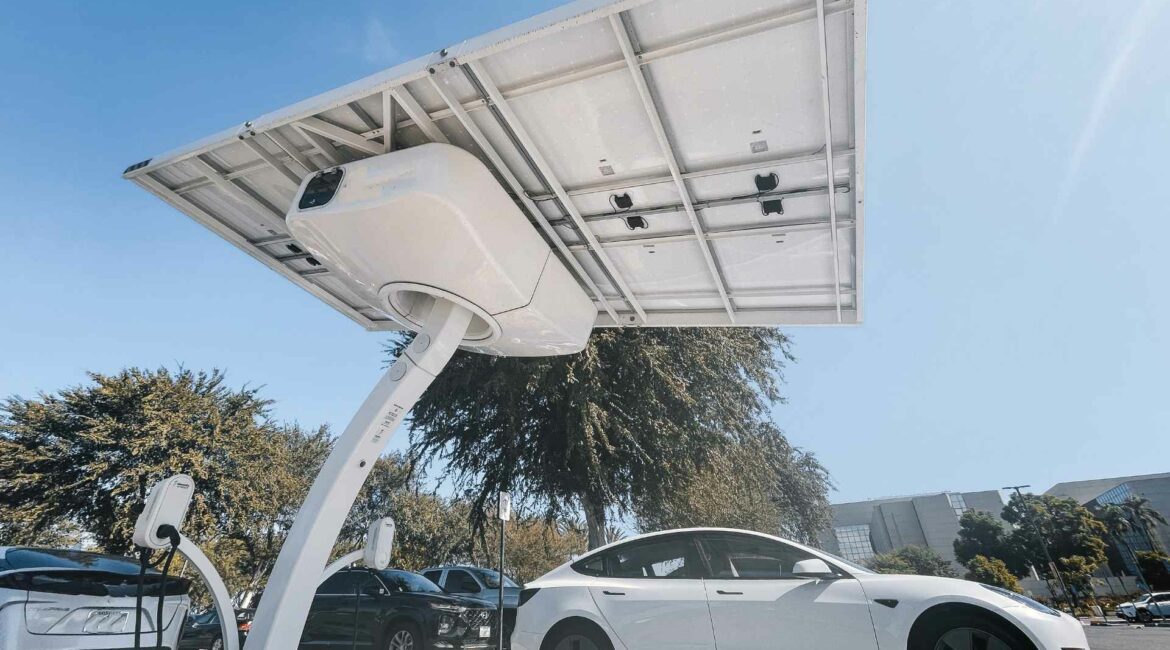In 2022, Tesla accounted for almost two-thirds (64%) of the United States electric vehicle market. There were more than 480,000 registrations of Tesla vehicles last year, including 228,000 Tesla Model Y registrations. These statistics highlight two important points: that electric vehicle popularity is soaring and so is the appeal of the Tesla brand.
Solar energy, likewise, is soaring in popularity in the United States. This brings us to an interesting question: How many solar panels to charge a Tesla? Given that a new solar project was completed in the U.S. every 44 seconds last year, it stands to reason that people are interested in purchasing both Tesla vehicles and solar panels.
Many environmentally conscious car owners are exploring sustainable options to power their vehicles. Of course, solar panels provide a clean and renewable source of power. This enables EV owners to reduce their carbon footprint while enjoying the benefits of cost-effective charging.
In this blog post, we will delve into the factors that determine the number of solar panels required to charge a Tesla. This will better help you understand how to harness the power of the sun for your electric vehicle. Let’s get started.
How Many Solar Panels to Charge a Tesla?
The first thing to say here is that the answer depends on a number of different factors. The good news is that it is absolutely possible to charge a Tesla electric vehicle using solar energy. Charging a Tesla is considerably cheaper than the cost of fueling a gas-powered car, too.
On average, it costs around $15.52 to charge a Tesla (which is less than five cents per mile). That means the cost is around three times cheaper than the cost of fueling a gas-powered car. The latter costs around 13.73 cents per mile to charge, highlighting the big cost difference.
To answer the question, a Tesla owner will require between eight and 10 additional solar panels on top of a regularly-sized solar panel system.
Important Factors to Consider
Let’s now look at some of the factors that determine the specific number of solar panels required. These include energy consumption, solar panel efficiency, and solar panel output.
Energy Consumption
There are several different Tesla models to choose from and each one is different. As such, specific energy requirements vary depending on factors such as:
- The specific Tesla model
- Battery size
- Driving habits
- Charging preferences
For instance, a Tesla Model S Long Range with a 100 kWh battery would require more energy compared to a Model 3 Standard Range with a 54 kWh battery.
Solar Panel Efficiency
Solar panel efficiency plays a crucial role in determining the number of panels needed to charge a Tesla. There are two different “types” of solar panels to choose from: Tier 1 and Tier 2.
Tier 1 solar panels tend to be more reliable. They are made by reliable solar panel manufacturers with a solid track record of producing solar panels. Effectively, they have a strong reputation for quality and service when it comes to solar panels.
A Tier 2 solar panel, then, is a term used to describe as non-Tier 1 solar panels. Tier 2 solar companies produce around a third of all solar panels, though they are not a recommended choice.
The bottom line is that opting for high-efficiency panels can help you maximize energy output. However, keep in mind that higher efficiency panels may come with a higher price tag.
Solar Panel Output
Several factors can affect the output of solar panels. These include:
- Geographic location
- Orientation
- Tilt angle
- Shading
- Weather conditions
Let’s take a look at each of these in turn as they will determine the number of solar panels required.
Geographic Location
The amount of sunlight a solar panel receives varies depending on the geographic location. It stands to reason that areas with more sunlight exposure will require fewer panels to generate the same amount of energy.
Orientation
In the U.S., solar panels should ideally face south in order to capture maximum sunlight. Installing solar panels in a direction other than south-facing will reduce their maximum output. For example, solar panels installed in a north-facing direction could experience an output loss of up to 30% compared to south-facing panels.
Tilt Angle
Solar panel angle refers to the vertical tilt of a solar system. The most appropriate tilt angle will depend on the geographic location.
For example, states located at lower latitudes, such as Arizona, require a low tilt to capture direct sunlight. On the other hand, states at higher latitudes, such as Oregon, require a higher tilt angle for maximum output.
Shading
Shading from trees, buildings, or other obstructions can also significantly impact the performance of solar panels. As such, it is important to ensure that the chosen location for panel installation is free from shading.
Many solar owners install solar panels on rooftops or in open areas. This comes with the benefit of generally being free of obstructions, such as trees and buildings.
How to Charge a Tesla With Solar Panels
When it comes to answering the question, How many solar panels to charge a Tesla? the answer is that it depends. Above, we have highlighted the main factors that determine the number of panels required for charging a Tesla. Ultimately, the cost of solar for charging a Tesla is far cheaper than fueling a gas-powered car.
If you are interested in learning more about solar energy and EV chargers, speak to Tapps Electric. We power your electrical contractor needs with professionalism and quality. Click here to get in touch with our team today.

Get Your Free Estimate
"*" indicates required fields


